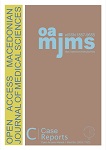Pseudoxanthoma Elasticum: A Case Report
DOI:
https://doi.org/10.3889/oamjms.2023.11091Keywords:
Pseudoxanthoma elasticum, Rare disease, Skin manifestations, Ophthalmologic manifestations, DermatopathologyAbstract
BACKGROUND: Pseudoxanthoma elasticum (PXE) is a rare, genetic, metabolic disease with autosomal recessive inheritance caused by mutations in the ABCC6 gene. The lack of functional ABCC6 protein leads to ectopic mineralization that is most apparent in the elastic tissues of the skin, eyes, and blood vessels. Dermatologic manifestations consist of small yellow papules on the nape and sides of the neck and in flexural areas that coalesce into reticulated plaques resembling the cobblestone aspect, and then the skin becomes loose and wrinkled. Histopathologic findings provide characteristic clues such as short, fragmented, clumped, and calcified mid-dermal elastic fibers.
CASE PRESENTATION: A 27-year-old Albanian female was referred to the dermatology clinic with skin complaints for approximately 17 years. On physical examination, we observed “cobblestone pattern” lesion located in the anterior, lateral, and posterior aspects of the neck, bilateral axillary, inguinal, antecubital, and popliteal regions, and periumbilical area. A biopsy was performed and the histopathology confirmed the typical changes in the dermis because of ectopic mineralization. The funduscopy revealed the “peau d’orange” aspect, bilateral angioid streaks but no neovascularization. Carotid echography showed minimal intimate thickening with flow acceleration but without significant stenosis of the right common carotid artery (ACC). Different laboratory exams were conducted that resulted within the normal range.
CONCLUSION: There is no specific treatment, and therapeutical management is based on prevention, tracking, and follow-ups to increase surveillance of clinical complications through a multidisciplinary team. The dermatologist is usually the first who faces Pseudoxanthoma elasticum manifestations. Therefore, the dermatologist should provide the patient with the best therapeutical and preventive approaches.
Downloads
Metrics
Plum Analytics Artifact Widget Block
References
Orphanet. The portal for rare diseases and orphan drugs. Available from: https://www.orpha.net/consor/cgi-bin/Disease_ Search.php?lng=EN&data_id=3728 [Last accessed on 2022 May 25].
Marques GM, Nakandakari S, Coelho AP, Nigro MH, Sabage J. Pseudoxanthoma elasticum: Report of two cases. An Bras Dermatol. 2014;89(5):812-5. https://doi.org/10.1590/ abd1806-4841.20143144 PMid:25184925 DOI: https://doi.org/10.1590/abd1806-4841.20143144
Uitto J, Li Q, Jiang Q. Pseudoxanthoma elasticum: Molecular genetics and putative pathomechanisms. J Invest Dermatol. 2010;130(3):661-70. https://doi.org/10.1038/jid.2009.411 PMid:20032990 DOI: https://doi.org/10.1038/jid.2009.411
Bercovitch L, Leroux T, Terry S, Weinstock MA. Pregnancy and obstetrical outcomes in pseudoxanthoma elasticum. Br J Dermatol. 2004;151:1011-8. DOI: https://doi.org/10.1111/j.1365-2133.2004.06183.x
Tan WC, Rodeck CH. Placental calcification in pseudoxanthoma elasticum. Ann Acad Med Singapaore. 2008;37(7):598-600. PMid:18695775 DOI: https://doi.org/10.47102/annals-acadmedsg.V37N7p598
Germain DP. Pseudoxanthoma elasticum. Orphanet J Rare Dis. 2017;12(1):85. https://doi.org/10.1186/s13023-017-0639-8 PMid:28486967 DOI: https://doi.org/10.1186/s13023-017-0639-8
Laube S, Moss C. Pseudoxanthoma elasticum. Arch Dis Child. 2005;90(7):754-6. https://doi.org/10.1136/adc.2004.062075 PMid:15970621 DOI: https://doi.org/10.1136/adc.2004.062075
Fukumoto T, Iwanaga A, Fukunaga A, Wataya-Kaneda M, Koike Y, Nishigori C, Utani A. First genetic analysis of atypical phenotype of pseudoxanthoma elasticum with ocular manifestations in the absence of characteristic skin lesions. J Eur Acad Dermatol Venereol. 2017;12:e147-9. DOI: https://doi.org/10.1111/jdv.14637
Esquivel-Pinto IA, Vega-Memije ME, Alvarado-Delgadillo A, Campuzano-Garcia AE, Manríquez-Robles A. Pseudoxanthoma elasticum: Report of two cases. Case Rep Dermatol. 2021;13(1):230-7. DOI: https://doi.org/10.1159/000513468
Plomp AS, Toonstra J, Bergen AA, van Dijk MR, de Jong PT. Proposal for updating the pseudoxanthoma elasticum classification system and a review of the clinical findings. Am J Med Genet A. 2010;152A:1049-58. https://doi.org/10.1002/ajmg.a.33329 PMid:20358627 DOI: https://doi.org/10.1002/ajmg.a.33329
Hosen MJ, Lamoen A, De Paepe A, Vanakker OM. Histopathology of Pseudoxanthoma elasticum and related disorders: Histological hallmarks and diagnostic clues. Scientifica (Cairo). 2012;2012:598262. https://doi.org/10.6064/2012/598262 PMid:24278718 DOI: https://doi.org/10.6064/2012/598262
Luo H, Li Q, Cao Y, Uitto J. Therapeutics development for pseudoxanthoma elasticum and related ectopic mineralization disorders: Update 2020. J Clin Med. 2021;10(1):114. https://doi.org/10.3390/jcm10010114 PMid:33396306 DOI: https://doi.org/10.3390/jcm10010114
Downloads
Published
How to Cite
Issue
Section
Categories
License
Copyright (c) 2023 Migena Vargu, Petrit Vargu, Sabina Dedej, Eriselda Kurushi, Alketa Tandili, Stela Ceca, Majlinda Çafka, Ilirjana Zekja, Ermira Vasili (Author)

This work is licensed under a Creative Commons Attribution-NonCommercial 4.0 International License.
http://creativecommons.org/licenses/by-nc/4.0








